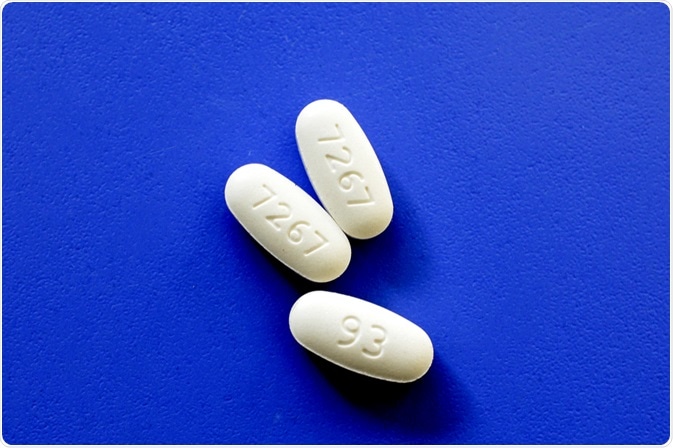Metformin represents a biguanide that has been used globally for the treatment of diabetes mellitus type 2 during the last five decades. It improves glycemic control by enhancing insulin sensitivity in the liver and muscle, while at the same time not being associated with hypoglycemia.
The drug has been increasingly used as a first-line agent for the treatment of type 2 diabetes – both as a monotherapy and as a component of combination regimens. The drawbacks of the drug are high dose (1.5-2 grams a day), low bioavailability (40-60%), and short biological half-life (0.9-2.6 hours), thus requiring repeated administration of high doses for maintaining effective plasma concentrations.

Metformin pills. Image Credit: agrofruti / Shutterstock
Drug formulations
A majority of currently available metformin formulations are immediate-release (IR) products, which release the whole drug within 1-2 hours after dosing, resulting in high drug concentrations in the gastrointestinal tract (potentially with undesired adverse effects). This drug formulation represents a regular version, taken at mealtime three times a day.
To counteract such common gastrointestinal side-effects, metformin slow-release (SR) and extended-release (XR) were introduced in 2004, allowing once-daily dosage. Such newer formulations release the active drug via hydrated polymers, which expand after the uptake of fluid. Research data confirm that the antihyperglycemic efficacy of such metformin formulation is comparable to immediate-release metformin given in divided doses.
The pharmacokinetic profile of metformin from the slow-release and extended-release formulations helps to avoid the rapid initial rise in plasma metformin concentrations seen with immediate-release metformin. Such smoother delivery of metformin may account for much of the improved tolerability demonstrated with the prolonged-release formulations.
In order to improve the oral bioavailability of metformin, the noisome (vesicular) system was developed. This system is characterized by nonionic surfactant vesicles that have a lamellar structure, formed by the self-assembly of surfactant molecules. Mucoadhesive ispaghula-sodium alginate beads also represent a novel delivery system utilized for the delivery of metformin.
Combinations with other drugs
Metformin is often prescribed with other antidiabetic drugs, which are sometimes even found in fixed combinations. One of the most popular is a fixed-dose combination of rosiglitazone and metformin. Such single tablet combinations show bioequivalence to the two drugs given as separate tablets, leading to fewer tolerability issues and similar levels of glycemic control.
Compared with metformin monotherapy, initial therapy with the fixed-dose combination of sitagliptin and metformin provided superior glycemic improvement with a similar degree of weight loss and lower incidences of abdominal pain and diarrhea.
Improved metabolic control can be achieved with preconstituted, fixed combinations of low-dose glyburide plus metformin in patients with type 2 diabetes. Studies have shown that this combination is more effective than either component monotherapy for adequate control of hyperglycemia in inadequately controlled patients with diabetes.
The fixed combination of dapagliflozin and metformin has been recently approved for adult patients with type 2 diabetes who cannot maintain adequate glycemic control just by exercising and dieting. The combination is suitable for people who are not helped sufficiently by taking metformin alone and who already take dapagliflozin and metformin as separate tablets.
Empagliflozin plus immediate-release metformin hydrochloride fixed-dose combination is on the way to the market, as the U.S. Food and Drug Administration has accepted the filing of a New Drug Application. Empagliflozin is a sodium-glucose co-transporter-2 inhibitor, designed to remove excess glucose through the urine by blocking glucose reabsorption in the kidney.
Metformin can also be used in combination with insulin where it shows an “insulin-sparing” effect, permitting approximately a 15–25% reduction in total daily insulin dosage. A decrease in insulin requirements may be of interest in diminishing peripheral hyperinsulinism and its eventual consequences.
Further Reading